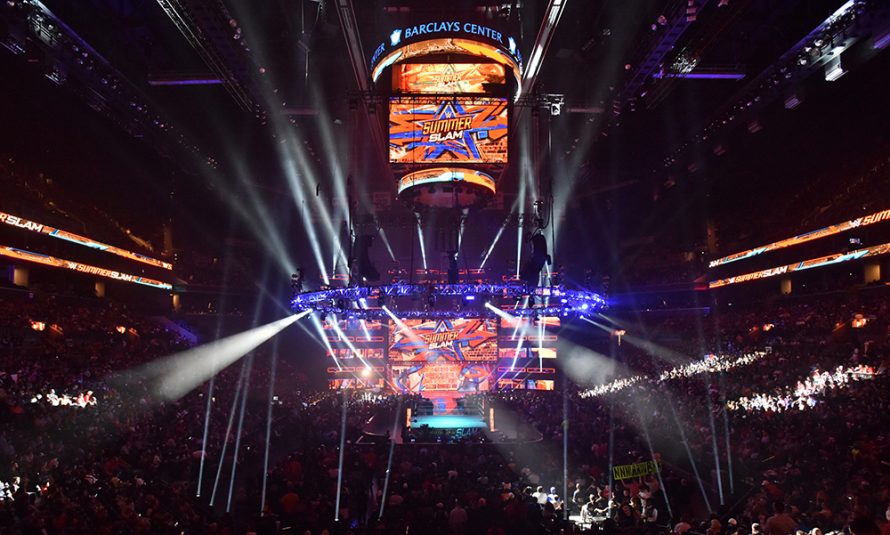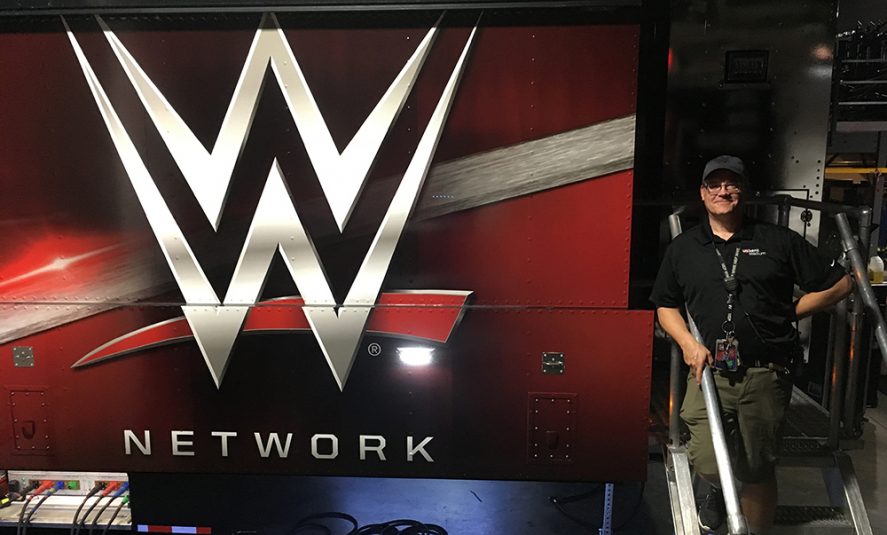WWE’s Perpetual Production Parade Returns to Barclays Center for SummerSlam
The second-largest PPV event on WWE’s calendar highlights its high-tech firepower
Story Highlights
WWE completed its annual four-day residency at the Barclays Center in Brooklyn on Tuesday, headlined by its second-biggest PPV of the year, SummerSlam, on Sunday evening. In addition to Sunday’s SummerSlam Kickoff preshow and SummerSlam main event (six-plus hours of programming), Barclays played host to NXT TakeOver: Brooklyn III on Saturday, Monday Night Raw, and SmackDown Live on Tuesday. The four-day caravan of events, which will return to Barclays again next year, adds to WWE’s already massive weekly production schedule and represents a major touchstone in its 52-weeks-a-year calendar.

SummerSlam took over the Barclays Center for the third consecutive year on Sunday and will return to Brooklyn again next year.
“SummerSlam is our second anchor PPV event, and it’s a very big show for us operationally, especially because of all the ancillary events [taking place around it],” Duncan Leslie, SVP, event technical operations, WWE, said last weekend. “But, frankly, we are used to grinding it out and doing big shows every single week. It’s an amazing anomaly for us to actually have a set day here [on Friday], because, normally, we can set a show this size in one day, [strike it] and be out the same day, and then up the next day and out the next day.”
WWE’s gargantuan road-show features 24 semi trucks in total for the event and live-broadcast elements of the show, including three trucks full of LED elements to construct its complete LED stage. A crew of more than 200 travels from city to city each week to produce what Leslie calls “a rock-and-roll show, a live-event production, and a television broadcast all in one.
“The crew understands that this is a marathon, not a sprint,” he continues. “We’re used to grinding it. and I have the best crew in the world, so that’s how we pull it off.”
Year 2 for NEP’s WWE Trucks Inside the Barclays Compound
WWE’s trio of state-of-the-art mobile units — WWE 1, 2, and 3 — made their second SummerSlam appearance after debuting in May 2016. The trucks are built around an Evertz EXE IP router, a Grass Valley Kayenne K-Frame switcher, and a 40-GBps fiber backbone. The trio also boasts a massive footprint (two double-expandos and a C unit) housing two control rooms (one for the main production, one for the preshow) and four audio-mixing rooms. The trucks’ four audio rooms handle the main mix (Calrec Artemis console), submix (Calrec Apollo), preshow mix (Calrec Apollo), and international feed (DiGiCo SD10B), respectively.
The trucks’ infrastructure and tools have continued to grow since their debut, with a total of 63 EVS streams (via seven EVS XT3 replay servers) now being sent to 448 TB of Dulce near-line storage in faster than real time. In addition, WWE is preparing to migrate its graphics to Ross Video’s Xpression platform this fall and has nearly finished transition to VoIP phone lines.
“We’re still mining the potential of some of the technology upgrades that we initiated within the truck,” said Leslie. “We’ve added a large amount of additional EVS [replay] and Dulce storage, and having VoIP phone lines will allow us to use the same phone number everywhere we go. And, as we migrate from Duet to Ross Expression, Ross has been working with us to tailor specific requests and needs that we have. They have been great about creating software and workarounds for us when necessary.”
In addition to carrying an IP video router, WWE’s trucks are among the first large-scale production units to exclusively use Dante IP-based networking for audio and comms.
“We’ve had some growing pains, but we’re very satisfied with the Dante application,” said Leslie. “There was a huge learning curve, but we’re very bullish on [Dante]. We started so big in the beginning that, at this point, we’re not really looking for additions; we’re looking for refinements and tweaks. We want a more robust and tolerant system of handshakes, because we found there were some areas that were more prone to failure. But we’ve been able to work through most of that and have it near perfect now.”
Connecting the compound to WWE headquarters for Aspera high-speed file transfer and other content exchange has also become integral to WWE’s weekly show. Over the weekend, WWE sent more than 500 GB of data between Barclays and WWE headquarters in Stamford, CT, over a dedicated 500-MBps pipe.
In addition, WWE served the needs of nine international rightsholders onsite, providing live announce positions (for Mandarin, Hindi, Portuguese, Russian, French, German, Spanish, English, and more) along “press row” in the stands.
Making A Baker’s Dozen Cameras Look Like Three Dozen
SummerSlam and the surrounding shows deployed 13 truck cameras off the NEP trucks (primarily Sony HDC 4300’s with Canon lenses), including multiple POV cameras. Although 13 cameras may not seem like a lot for a PPV production the size of SummerSlam, Leslie and company have mastered the art of repositioning cameras throughout the show to capture a variety of different perspectives.
“We move a lot of cameras to different drops during the show, so it looks like there’s more cameras than there actually are,” he said. “I’ll have a jib, two or three hards, a Steadicam, and a couple other handhelds around the ring. But then, we have our Camera 5, which will probably have four drops in the arena, another four backstage, and one up top on the marquee. And we have two other backstage truck cameras, 10 and 11, and can repo them other places as well. We also have three cameras dedicated to the pre- and post-shows that can be moved. So we could have 30-40 drops with the hardware of only 13 cameras.”
In addition to the primary cameras, WWE demonstrated a new RF camera from CP Communications during the SummerSlam PPV. According to CP Communications President Michael Mason, the multifaceted system was equipped with RF video links capable of transmitting all formats, including 1080p. In addition, the IP-based paint-control system developed by CP engineers not only gives the V1 full control of the camera, but the user can also use it simultaneously for return video (as was the case at SummerSlam).
“We’re always thinking about how to make [our shows] newer, nimbler, better, stronger, and faster,” said Leslie. “But we don’t want to be adding new equipment for the sake of adding new equipment, so, for SummerSlam, we repurpose a lot of the technology that we have for Raw and SmackDown, which are huge shows on their own. We want to spend our time on making the matches and the storylines more exciting and complex. Then we use our very large existing bucket of toys to cover it, and, when it’s appropriate, we will add new tools to help tell the story.”

